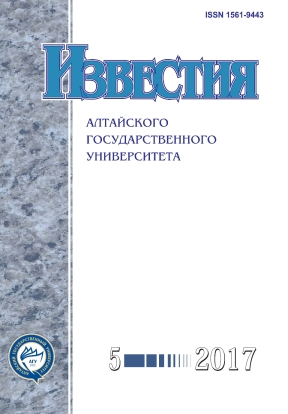The Dynamics of the Parish Building in the Eparchy of Omsk in 1895-1917
Abstract
The article analyzes the dynamics of the parish building of the Omsk Eparchy since its formation in 1985 and until 1917. Geographically, most of the Omsk Eparchy was taken by the Steppe governor-generalship with the Akmola and Semipalatinsk regions, in ethno-confessional terms populated by Muslims, Orthodoxies and Old Believers communities. Therefore, the Russian Orthodox Church played an important role in the spiritual leadership of the region and the implementation of the policy of Russification. To achieve this goal in the end of the 19th the Omsk Eparchy appears on the map of Western Siberia.
As a result of the sources analysis the author has divided the process of construction of the Omsk Eparchy in two stages. The first stage was associated with the beginning of the mass migration of the peasant from the European part of the country to the territory of the Steppe region and thus with a sharp increase in the Orthodox population in the region. This phase was characterized by the slow pace of parish construction in the Omsk diocese, unpreparedness of the diocesan authorities for an influx of migrants. The second phase, associated with the beginning of Stolypin's agrarian reform in 1905, was characterized with even a more dramatic increase in the Orthodox population in the steppe region. In order to meet the spiritual needs of displaced persons and securing the positions of the Russian Orthodox Church in the steppe region at the legislative level the decision was made to increase the pace of construction of the parish in the Omsk Eparchy due to government subsidies ed. As a result, the Omsk Eparchy in 1915 was able to increase the number of churches in 3.5 times.
DOI 10.14258/izvasu(2017)5-05
Downloads
Metrics
References
Моррисон А. Центральная Азия в составе Российской империи // Новое литературное обозрение. — М., 2008.
Первая Всеобщая перепись населения Российской империи 1897 г.: Акмолинская область. СПб., 1905.
Первая Всеобщая перепись населения Российской империи 1897 г.: Семипалатинская область. СПб., 1905.
Первая Всеобщая перепись населения Российской империи 1897 г.: Тобольская губерния. СПб., 1905.
Голошубин И. Справочная книга Омской епархии. — Омск, 1914.
Российский государственный исторический архив (РГИА). Ф. 796. Оп. 442. Д. 1965.
Лысенко Ю.А. Русская православная церковь в религиозном пространстве Казахстана: этапы и особенности институционального оформления (XVIII — начало ХХ в.) // Былые годы. №3. — Сочи, 2014.
Отчет о деятельности Омского епархиального миссионерского совета за 1915 г. // Омские епархиальные ведомости. — 1916. — №12. — 15 июня.
Лысенко Ю.А. Очерки истории Русской православной церкви в Казахстане (XVIII — начало XX в.). — Барнаул, 2011.
РГИА. — Ф. 796. — Оп. 442. — Д. 2287.
РГИА. — Ф. 796. — Оп. 442. — Д. 2161.
Алексеенко Н.В. Население дореволюционного Казахстана. — Алма-Ата, 1981.
Государственный архив Омской области. — Ф. 16. — Оп. 1. — Д. 122.
Лысенко Ю.А. Религиозная политика как механизм закрепления имперских позиций в Туркестанском крае (вторая половина XIX — начало ХХ в.) // Вестник Томского государственного университета. — 2012. — № 4.
Copyright (c) 2017 Н.В. Дикова

This work is licensed under a Creative Commons Attribution 4.0 International License.
Izvestiya of Altai State University is a golden publisher, as we allow self-archiving, but most importantly we are fully transparent about your rights.
Authors may present and discuss their findings ahead of publication: at biological or scientific conferences, on preprint servers, in public databases, and in blogs, wikis, tweets, and other informal communication channels.
Izvestiya of Altai State University allows authors to deposit manuscripts (currently under review or those for intended submission to Izvestiya of Altai State University) in non-commercial, pre-print servers such as ArXiv.
Authors who publish with this journal agree to the following terms:
- Authors retain copyright and grant the journal right of first publication with the work simultaneously licensed under a Creative Commons Attribution License (CC BY 4.0) that allows others to share the work with an acknowledgement of the work's authorship and initial publication in this journal.
- Authors are able to enter into separate, additional contractual arrangements for the non-exclusive distribution of the journal's published version of the work (e.g., post it to an institutional repository or publish it in a book), with an acknowledgement of its initial publication in this journal.
- Authors are permitted and encouraged to post their work online (e.g., in institutional repositories or on their website) prior to and during the submission process, as it can lead to productive exchanges, as well as earlier and greater citation of published work (See The Effect of Open Access).








